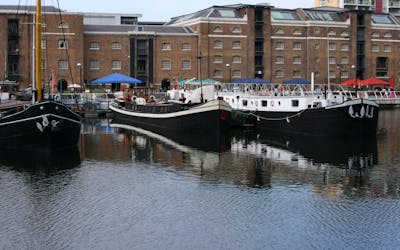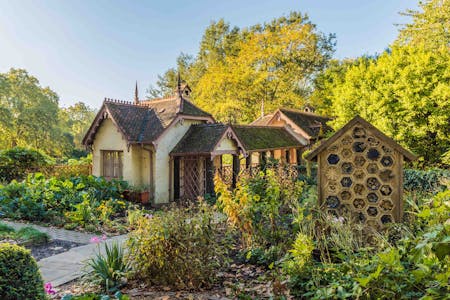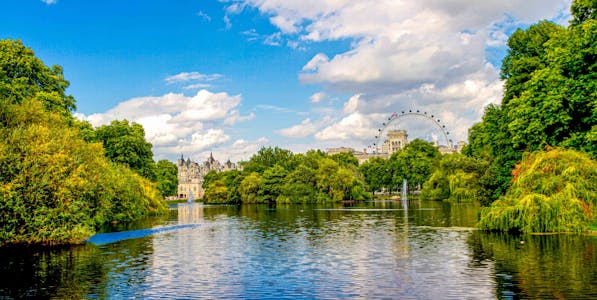London's packed with museums, but there's one hidden gem that played a crucial role in Britain's WWII victory. Tucked away in central London, the Churchill War Rooms offer a unique glimpse into the nerve center of the British war effort. This underground bunker, where Winston Churchill and his team made history-altering decisions, is now open to the public as part of the Imperial War Museum.
For history buffs, it's a must-visit spot that brings the intensity of wartime Britain to life. You'll feel like you've stepped back in time, surrounded by the very rooms where strategies were planned and executed.
Ready to explore this fascinating slice of history? Here's your guide to visiting the Churchill War Rooms without any hassle.
Churchill War Rooms in a Nutshell
Handy information
| ⏰ Suggested Duration: | 2-3 hours |
| ☀️ Best Time to Visit: | Morning or Evening |
| 💜 Must See: | The Map Room |
| 🎟️ Churchill War Rooms Ticket: | €25 |
| 🚆 Closest train station: | Charing Cross |
Must-see
The War Cabinet Room
The Map Room
Churchill’s Office-Bedroom
Churchill Artifacts
Churchill’s Siren Suit
Things to know
Number of visitors per year: 4 million
Established: 1939
Number of Cabinet rooms : 30
Depth of Churchill's Bunker: 40 Feet
Opening Hours And Address
Daily 9:30am to 6pm
Address : Clive Steps, King Charles St, London SW1A 2AQ, UK - 9
Get Directions
What are the Churchill War Rooms
The Churchill War Rooms is a secret underground headquarter and one of the 5 parts of the Imperial War Museum. The secret tunnels were used by Prime Minister Churchill and his government officers. These headquarters were used during World War II for meetings and to provide summaries for King George VI
It located in the former underground government bunker that sheltered Prime Minister Winston Churchill and his cabinet during the Blitz of World War II. The war rooms are now a museum that tells the story of Churchill's leadership during the war.
Walk through the underground headquarters to see where Churchill and his War Cabinet met. Go through the Cabinet War Rooms that saved Churchill and his officers during the Blitz. Reveal the stories of people, places, and events of WWII through the wide collection of artifacts, documents, and photographs.
Best way to buy Churchill War Room Tickets
The Churchill War Room tickets are available here. You can buy tickets that will grant you access to the museum. The admission to the Churchill museum ticket also opens gates and access to audio guides, a cafe, a souvenir shop, and much more.
BONUS: Get exclusive tickets to Madame Tussauds London
Top 10 things to see inside Churchill War Rooms

#1. The War Cabinet Room
This historic space is where Churchill and his team made crucial war decisions. It offers a glimpse into wartime strategy and daily life. The room features Churchill's custom high-backed chair, designed for comfort during long meetings while wearing his iconic siren suit.
#2. The Map Room
The Map Room served as the operational hub, tracking war progress and planning military actions. Continuously staffed, it provided real-time updates on Allied and Axis movements. Churchill spent D-Day here, making crucial decisions. Preserved as it was in 1945, the room displays original maps and equipment, offering a glimpse into wartime technology.
#3. Churchill’s Office-Bedroom
Prime Minister Churchill had his personal room in the Cabinet War Rooms, which was set next to the Map Room. He used the rooms to host meetings, fetch information, and make war plans. Get to the room to see where Churchill took his day naps. You will also see a desk equipped with a microphone that was used for communication and linked to the Broadcasting Room.
#4. Room 60 - BBC’s Broadcasting Room
To broadcast the speech and information, Churchill planned a BBC Broadcasting Room. The BBC room was an equipment room that was connected to the Broadcasting House, Maida Vale studios, and Churchill’s bedroom. See a private Transatlantic Telephone Room, where Churchill used to speak in secret to the President of the United States. Churchill made four wartime broadcasts from the Cabinet War Room that was next to his office bedroom.
#5. Churchill Artifacts
Know about the life and war journey of Churchill and listen to the stories of staff who spend their time here.
- His childhood (1874-1900)
Churchill was born on November 30th, to the American socialite Jennie Jerome and Lord Randolph Churchill. He graduated as a cavalry cadet from Sandhurst Royal Military Academy in December 1894. Soon after, Churchill was on his journey in the British Army. - His entry into politics (1900-29)
Churchill entered politics in 1901 when won his first election in February. He got into the House of Commons. After that, he got married in 1908 to Clementine Hozier who was the daughter of Sir Henry Hozier and Lady Blanche. Churchill was appointed the First Lord of the Admiralty or Civilian Head of the British Navy by the Prime Minister in 1911. - His political exile (1929-39)
During this duration, Churchill left politics. He was on the first lecture tour in the US in 1931. However, soon in September 1939, Churchill was called to serve in government. - Churchill’s time as Prime Minister(1940-45)
When Churchill became First Lord of the Admiralty, soon in 1940 he became Prime Minister. When the war started, Churchill gave his first speech to the crowd. On this day, he gave his ‘Finest Hour’ speech in June 1940 which inspired the British people to fight. - His life after the war (1945-65)
After the Second World War, he won and was elected as Prime Minister for the second time. He became the First Lord of the Treasury during 1951-55. Churchill won the “Nobel Prize for Literature” in 1953. He served as an MP and gave 60 years to Parliament until he retired from politics. Churchill died on 24 January 1965 and was granted a state funeral by HM Queen Elizabeth II.

#6. Churchill’s Siren Suit
The Churchill Siren Suit was a one-piece garment with breast pockets to keep a cigar and a belt. Churchill used to call them 'romper suits'. The suits were comfortable and could be worn all day long. The Siren Suits were worn by both children and adults and were very comfortable to wear during the shelter.
#7. Working for Winston Section
During the Second World War, history was made in Churchill War Rooms. The underground area was occupied by Britain's leaders and workers to plot the victory. Relive the moments of planning during the Second World War.
#8. Kitchen in Churchill War Rooms
Visit the kitchen at the Churchill War Rooms museum to see how meals were cooked during the Second World War. See the pots and pans from the era that belonged to Winston's cook - Georgina Landemare, who offered her services during the war times.
#9. The Transatlantic Telephone Room
Discover a secret cupboard room hidden as a private toilet. In this hidden cupboard room, Churchill used to talk and discuss secret matters with the President of the United States. At the time of the Second World War, this was the cutting-edge technology of the day.
History of the Churchill War Rooms
In 1936, the British government ordered a temporary emergency government center. The officers suggested a suitable site was the basement of the New Public Offices (NPO). The building was located on the corner of Horse Guards Road near Parliament Square. Under the supervision of Ismay and Sir Leslie Hollis, the broadcasting equipment, communication equipment, ventilation, and reinforcement were installed in the building in June 1938.
During the war, the two rooms were majorly used, one is operational, the facility's Map Room and Cabinet Room. When Churchill became the Prime Minister, and when he visited the Cabinet Room in May 1940, he declared "This is the room from which I will direct the war".

Churchill War Rooms - Design
- The Churchill War Rooms has been welcoming visitors and history lovers since 31 May 2012. Apart from being a historic landmark, the museum design is a fusion of architecture and sculpture.
- During the Blitz, the switchboard operators and typists had to remain underground day and night, sleeping between shifts
- During the war times, in the underground, 'sunburn' was common. Once a girl forgot to put on the goggles and nearly went blind.
- While 115 cabinet meetings were held here, Churchill made four speeches from his underground bedroom.
Best time to visit Churchill War Rooms
May to August is peak season for visiting the Churchill War Rooms, while November to March is quieter. For the best experience, arrive at opening time (9:30am) when crowds are thinnest. Early mornings on weekdays, especially Wednesdays and Thursdays, offer a more relaxed atmosphere. Avoid Saturdays if possible, as they tend to be busiest. To beat the crowds, book your tickets for early morning slots.
How to reach the Churchill War Rooms?
- By Tube:
Reach Westminster or St James’s Park (District and Circle Line) to reach Churchill War Rooms by Tube. 17 - By Train:
If you are choosing Train as the transportation to reach Churchill War Rooms, then arrive at Charing Cross which is a 10-minute walk. You can also reach Victoria (a 15-minute walk) and Waterloo (a 20-minute walk). - By Bus:
Lines 3, 11, 12, 24, 53, 87, 88, 109, and 148 will take you to Churchill War Rooms. - By Car:
Reaching Churchill War Rooms by car is the most convenient and fastest way to reach here.
The nearest parking to the Churchill War Rooms are Abingdon Car Park and Trafalgar Car Park.
Churchill War Rooms facts that you probably didn't know
- Do you know that Churchill War Rooms are two completely different museums? The two museums are Cabinet War Rooms and Churchill Museum. The Cabinet War Rooms show the underground complex that was used by the government and the Cabinet War Rooms show Prime Minister Churchill’s life.
- Although it is said that 115 cabinet meetings were held here, not all the meetings were attended by Churchill.
- The first meeting held here was in October 1939 under Prime Minister Neville Chamberlain.
- In 1945, the rooms were closed and reopened in the 1980s by the Imperial War Museums as a tourist attraction.
- Sunburn was quite common during wartime and artificial sun lamps were installed. The workers needed to stay in front of the lamp.
Accessibility/ Disability Facilities in the Churchill War Rooms
- Churchill War Rooms are wheelchair accessible.
- Wheelchairs are available on site for visitors (subject to availability).
- A lift is available for disabled visitors to the historic rooms.
- Toilet facilities are available at the basement level.
- A free hand-held audio guide is available with an earpiece for those who have hearing-impaired issues
Restaurants near Churchill War Rooms

An ideal place for those who want to experience pub dining in London. The place serves international beers with delicious cuisine.

Step into the restaurant to experience the best ambiance and vibe. Select and try some new dishes from the Alpine-inspired menu.

Famous as “pub on the Thames”, this restaurant is located opposite the London Eye. Enjoy delicious dishes and views of the London Eye with Tattershall Castle River.

Not like any other Indian restaurant, this restaurant has outstanding food with books lining the walls. The team of 18 chefs makes mouth-watering food.
Things to do around Churchill War Rooms
1Duck Island Cottage Garden
The garden was a hunting ground for St James's Park and Charles II converted it to a baroque park. The park was destroyed in 1771 and rebuilt after 1840 in the Arts and Crafts style.

2HM Treasury
Also known as the Exchequer, the HM Treasury is the department of the Government of the United Kingdom. The department is responsible for handling the Online System for Central Accounting and Reporting and is a major tourist attraction in London.

3Guard's Division Memorial
The memorial is in the memory of Guardsmen who died in World War I. Designed by H. Chalton Bradshaw, it was unveiled in 1926. You can see the small hole in the sculpture that was got damaged by German bombs during WWII.

4St. James's Park
Offering views of Buckingham Palace, Big Ben, and the London Eye, St. James's Park is famous for flora and fauna. The park is home to ducks, geese, and even pelicans and is an ideal place for nature lovers.

Churchill War Rooms- Facilities & Services
- There is a washroom facility in the basement for visitors.
- You can relish your taste buds at on-site restaurants that remain open from 10.00 am to 05.00 pm. The restaurant serves authentic classic British food and home-cooked pies.
- Visit the on-site shop to buy unique gifts and souvenirs. The shop offers a wide range of books, clothing, accessories to vintage posters, homeware, toys, and much more.
- The descriptive audio guides are available in various languages. You can choose from English, French, German, Italian, Spanish, Hebrew, Portuguese, and Mandarin.
- Audio guides are available at the audio-guide desk (subject to availability).
Churchill War Rooms Reviews
Really informative tour guide who gave us some incredibly unknown insights into English history. A fabulous walking tour and wonderful experience in Churchill's chambers - definitely not to be missed.
- Grace, Headout, April 2024
The war rooms were very interesting and very informative Thank you.
- Jeremy, Headout, August 2023
Insider tips to know before visiting Churchill War Rooms
- Photography is allowed during Churchill War Room tours. However, tripods and commercial photography are not allowed in the rooms and museum.
- There are no locker rooms at the site. It is advised to carry small bags.
- Carry a water bottle to stay hydrated throughout the visit.
- Look for friendly and knowledgeable volunteers who will be wearing red uniforms. Make the most of your day and time.
- The opening time of the cafe is 10.00 am to 05.00 pm with the last orders at 4.45 pm. Also, order hot food until 03.00 pm.
- Access to the Café is only available with Churchill war rooms tickets to the museum.


